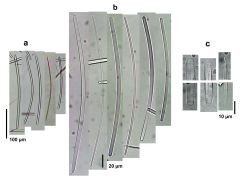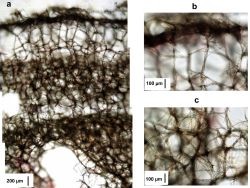yellow
cinnamon-tan
fan
lobate
massive
crumbly
tough
Bahamas
Colombia
Amphimedon? sp.-"castle morphotype"
Description: This species forms thick encrustations that grow upwards to steep, ridged hills, and even more to sheer-faced, castle-like formations with cylindrical or flattened “battlements”. Size to about 50 cm wide and high. Surface smooth, with scattered oscules, sometimes darkly colored, up to about 1-2 cm in diameter, generally deep and vertically walled. Color as various tones of yellow with purplish to cinnamon shades; some specimens are entirely cinnamon-tan; subsurface color reddish brown (possibly from cyanobacteria), internal color cream. Consistency compressible, spongy, but slightly tough to cut or to tear. Skeleton as ascending paucispicular (1-5 spicules across) tracts variably enveloped by spongin, up to about 50 µm thick, separated some 125-200 µm, irregularly interconnected by single spicules or spicule tracts, forming a slightly rounded reticulation of 100-200 µm mesh diameter. Growth bands can be discerned near the surface. At the surface, spicules are confusedly and more densely arranged in a paratengential fashion. Deeper in the choanosome, spicule fiber tracts are thicker (up to 8 spicules), and there are many spicules strewn in confusion in between spaces of the main reticulation. Spicules are strongyles, slightly curved, in an ample variety of sizes, 140-260 µm long and 2-7.5 µm wide in the Bahamas, and 237-385 µm in the San Andrés Archipelago (SW Caribbean, Colombia); endings are from rounded, to slightly rugose to mammiform, being slightly asymmetric, one end slightly narrower than the other; developmental (thinner) stages tend to have narrower ends, towards oxeote.
Notes: This is a deep reef species, living exposed. There are three distinct morphotypes (herein named "branching", "castle" and "tubular") of slightly toughly compressive to crumbling, yellow to tan sponges, that share a skeleton of slightly asymmetric strongyles arranged in ascending and interconnecting fiber tracts. We have tentatively called them Amphimedon? following the Systema Porifera (Hooper & van Soest, 2002) and in particular for the similarity in skeletal arrangement to A. viridis Duchassaing & Michelotti, 1864, also pictured here. For further discussion see notes on the "branching morphotype". Some specimens of this "castle morphotype" in the Bahamas can be confused in the field with thickly encrusting specimens of Svenzea? flava (Lehnert & van Soest, 1996), which are distinguished for having more slender and slightly sinuous strongyles with styloid instead of oxeote developmental stages; S. flava in the southern Caribbean has exclusively styles and styloids.

![<i>Amphimedon? </i> sp.-"castle morphotype" <br />[Bahamas, Little Inagua]](mini/00108/01780.jpg)
![<i>Amphimedon? </i> sp.-"castle morphotype" <br />[Colombia, San Andrés Archipelago, Old Providence Island]](mini/00115/01940.jpg)
![<i>Amphimedon? </i> sp.-"castle morphotype" <br />[Colombia, San Andrés Archipelago, Serrana Bank (atoll)]](mini/00115/02007.jpg)

